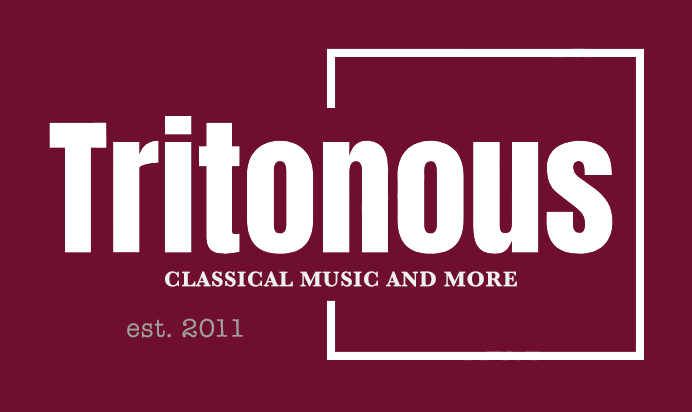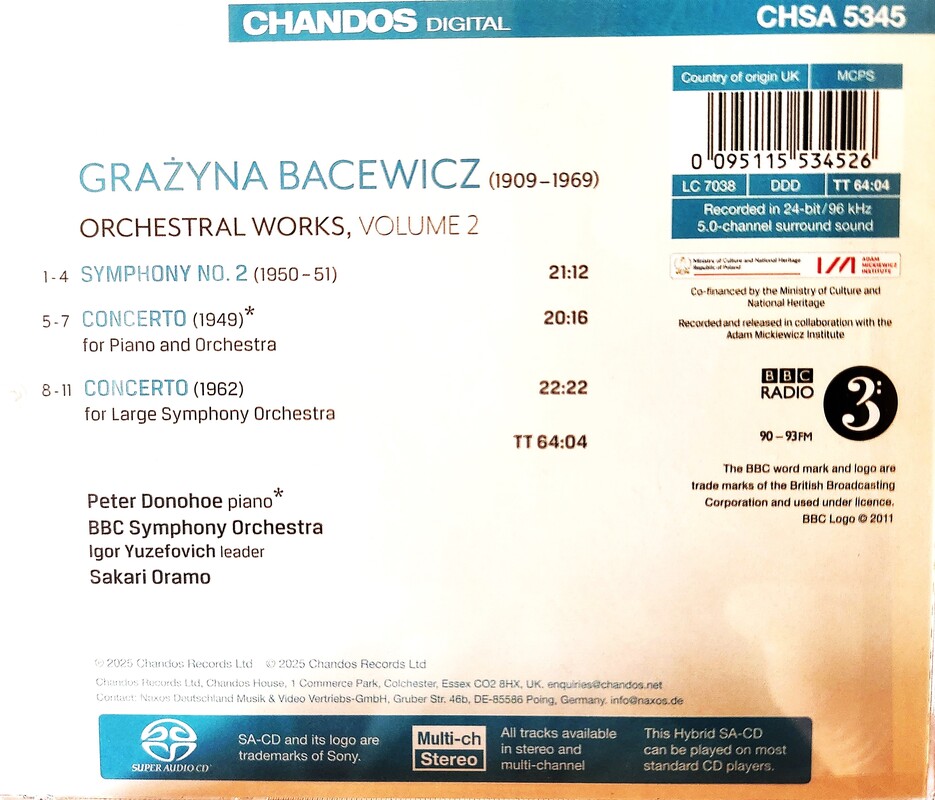I was surprised the symphony comes first on the program, before the piano concerto, which doesn’t make much sense musically. You’d never see it programmed this way on a live concert. But I was eager to hear if this symphony is as wonderful as those on the first volume, so I gave it a casual listen to whet my appetite. And oh yes, it is absolutely wonderful – as is the recorded sound. I took a few cursory notes and decided to come back to it later for a more comprehensive listen, and write a full review.
I began listening more intently as the Piano Concerto began playing next. I really wanted to hear Peter Donohoe and Oramo play this, as I had come away with only a lukewarm impression of the piece listening to the 2023 Ondine recording played by pianist Peter Jablonski. (Please see my review here on the blog.) And right off the bat, I noticed something a bit strange with the recorded sound. My notes say: “this sounds funny”. And after listening for a few minutes, that feeling persisted and distracted me from enjoying the music.
Perplexed, I set this aside and came back to it again a few weeks later. This time I started with the Piano Concerto, and once again immediately thought, oh this does sound “funny”. It’s rather hard to describe, but the piano sounds a little “boxy”, like the lid is closed, and somehow distanced from the orchestra, almost in its own acoustic. And too, even the orchestra sounds a bit misty and indistinct. So it’s time to figure out what’s happened here. Going back to the aforementioned Ondine recording for a quick listen, I immediately hear a much more natural piano tone, along with vivid, more beautiful orchestral colors. The musicmaking is more alive, engaging and interesting, and I found myself being drawn into the music in a way I didn’t with the Chandos. So much so, I began to think I may have underestimated the Ondine recording in my review.
But matters changed as I listened further. I tried the 3rd movement Molto Allegro next, where comparisons really got interesting. Chandos has suddenly given their piano a more lifelike presence, and the orchestra a more vivid focus. Ah-ha! They must have heard something was amiss in the first movement and corrected whatever was wrong for subsequent recording sessions. And now the musicmaking on Chandos comes alive and is in every way preferable to the Ondine. The tempo is faster and the playing from pianist and orchestra alike is less ponderous.
Going back to the beginning again to concentrate solely on the Chandos, musically, I found the first movement to be rather meandering and a little strange, not helped by the recorded sound, which obstinately refuses to draw the listener into the music. The Andante is better, played at a slightly more moving tempo than on Ondine. And the recording begins to improve as well. While the finale is really quite excellent compared to Jablonski’s reading, played here with more verve and less heaviness, as noted above.
My apologies for the long-winded commentary about this concerto. But I found it not terribly persuasive in either recording, though admittedly for different reasons. I would have expected it to be more formally structured and musically compelling. The Chandos booklet goes into great detail about its compositional inception – pondering over its “hidden meanings” and “poetic riddles” and “disguised” use of folk melodies. Whatever. I wish there was less mystery and more obvious incorporation of folk melodies, as I consistently longed for more thematic melodiousness in the music.
So in the end, is this a good piece? Ehhh. It’s OK. I’ve listened attentively to 2 different recordings of it and ultimately came away with the same impression both times: it’s good but eminently forgettable.
Moving on to the Concerto for Large Symphony Orchestra however, everything changes. Very much for the better – though the very opening doesn’t begin promisingly. It is based on a note cluster – D#, E and F on the horns and trombones, so you can imagine what you’re going to hear and what this is going to sound like. The opening measures are pretty unpleasant, especially as Bacewicz intensifies the deliberate dissonance with a sizzling cymbal roll on top of it – all for no apparent musical reason. It reminds me of her similarly dissonant Double Piano Concerto (heard on the same aforementioned Ondine CD), written 4 years later, as this incorporates the piano rather prominently in places. But the music becomes much more interesting (and gratifying) as she settles down for the piu mosso-molto ritmico. And even more so in the poco piu mosso which follows, where she incorporates some interesting string effects (such as col legno and wild glissandos), along with interesting percussive interjections from the piano and xylophone. The orchestration here really is innovative and fascinating.
The Largo is gloriously atmospheric – hypnotic and otherworldly – and superbly orchestrated with an imaginative sonic palette of color. It is expressive and stark at the same time, and sensitive too. Oramo is masterful at conducting this kind of music, and he draws exquisite playing from his orchestra. The massed string glissandi, for example, are extraordinarily effective – intriguing, unsettling and downright eerie. As is the passage which follows, ingeniously utilizing a variety of tuned percussion like vibraphone, xylophone and celesta (and there are two harps as well) to create unusual tapestries of sound. It has a somewhat blurred, almost impressionistic feel to it, along with distinct hints of Bartok. My notes say “Nice”. And my heart says, oh, I really like this.
The Vivo starts with more purely atmospheric string writing, incorporating icy effects (sul pont) and more glissandi, punctuated with percussion and woodwind interjections. Bartok makes an even stronger presence here – reminding me not of his own Concerto for Orchestra, but his much earlier ballet, The Miraculous Mandarin. Bacewicz even incorporates bongo drums (and other percussion) along the way, propelling its rhythmic energy under the gossamer, silky string gyrations. And with its continued resemblance to Bartok’s ballet, it remains superbly evocative and atmospheric, and again I’m really liking this. A lot. (Not surprising, as Bartok’s Miraculous Mandarin is one of my favorite pieces of music.)
The final Allegro non troppo is notable for interesting orchestral effects and frequent punctuations from piano and a multitude of percussion. It sounds very modern and continues to evoke Bartok – late Bartok now. But there are moments of tonality too, struggling to emerge. But it’s the rhythmic drive which propels it, especially in the presto middle section. But it gets a little weird as it makes its way to the end, ultimately reminding me more of Lutoslawski than Bartok. It ends very abruptly, with a quick outburst of percussion rather than a big climactic peroration from the full orchestra, making me again wonder why it comes at the end of the program.
I don’t think “Concerto for Orchestra” is really the best descriptor for this piece, as it doesn’t feature much soloistic playing, or even choirs of ensembles. Nor is it virtuosic like we’d expect from a true concerto for orchestra. Instead, it explores atmosphere, color, texture and innovative orchestration above all else. Thus it seems more like a Sinfonia or perhaps an unnumbered symphony – or even more, a grand symphonic tone poem. But no matter, it is ever so close to being a masterpiece, and the performance of it here is absolutely sensational. Though interestingly, Oramo is a tad slower in all four movements than on the only other recording of it I could find, with Lukasz Borowicz conducting the WDR Symphony Orchestra on CPO. I need to acquire that CD for comparison’s sake. And, more importantly, the piece is so rewarding, it merits a second listen.
Finally, going back to the very beginning for the raison d’etre for this release (which surely should have come last on the disc), we hear the wonderful Second Symphony. And it is simply glorious – and gloriously recorded, returning us the wondrous sound heard in Symphonies 3 and 4 on Volume One. These 3 symphonies were written in quick succession – 1951, 1952 and 1953 respectively – so they reasonably should all inhabit a similar sound world. But they are fascinatingly different from one another – the 2nd, strikingly so.
The first movement is marked con passione, and Oramo interprets that brilliantly. He imbues it with passion, yes, but not a bit of heaviness or overindulgence. After the grandiose opening, the Allegro sentimento is less richly Baxian than the later symphonies, avoiding the chordal blocks of sound utilized so prominently in, especially, the 3rd. It is more impressionistic in its harmonic progression and fluid melodic lines, with leaner harmonies and more transparent orchestration. And as the Allegro develops, Oramo generates great momentum and excitement, then relaxes beautifully in the back-and-forth swelling and subsiding of the many meno mosso and piu mosso markings in the score – sounding at all times utterly spontaneous. I kept thinking over and over what a marvelous composer Bacewicz is and how refreshingly original this piece is.
The Lento tranquillo is exactly that – gloriously tranquil over a constantly moving, walking motif in the lower strings. And as the melody expands in the poco piu mosso, the upper strings are ravishing, as played by this fantastic orchestra. Yet Oramo doesn’t allow it to become burdened with excess emotion – for even here, the transparency in the scoring remains a priority. And there is a certain disquietude underlying the illusive tranquility in the final section, which is spellbinding. The atmosphere of uncertainty here is awesomely portrayed by Oramo and the recording engineers. Oh my goodness, what a glorious piece of music this is.
The Scherzo vivo then takes off with energy and vigor, but also a delightful fleetness as well – at a perfectly chosen tempo. Oramo is once again masterful in preventing the music from weighing itself down, while allowing dynamics to expand with power and effortless ease into the acoustic (helped in no small part by the Chandos engineers). He again generates plenty of momentum and sheer excitement as well. It would be near impossible for an audience to refrain from spontaneous applause at the conclusion of this vivacious little scherzo (which lasts just under 4 minutes). But there is more!
The finale is a nice contrast to the Scherzo, marked Allegro moderato, which Oramo again judges perfectly. The massed strings are very impressive here – with just enough bow-on-string articulation to propel the sheer body and weight of their sound without becoming heavy. And while it’s not overtly fast, Oramo brings enormous impetus and drive. And the variety of moods keeps the listener engaged in rapt attention, as Oramo thoroughly immerses us in Bacewicz’s inspirational and truly inspired creativity and imaginative orchestration. The piece ends with grandeur and panache – which would surely bring the audience to its feet.
And it’s no wonder the Piano Concerto didn’t make a more favorable impression, coming after the triumphant conclusion of this symphony.
This Symphony is another magnificent piece of music by this highly accomplished and endlessly impressive, pioneering composer. Its relative neglect is absolutely unconscionable and indefensible. Fortunately for us, it couldn’t possibly be afforded a more persuasive or rewarding performance than this one with the wonderful conductor, Sakari Oramo, and his equally wonderful orchestra. And the superlative recorded sound from Chandos brings it into the listening room with splendor and realism. With the exception of the Piano Concerto, orchestral recordings don’t get much better than this – musically, performatively, or sonically. I enjoyed it immensely.












